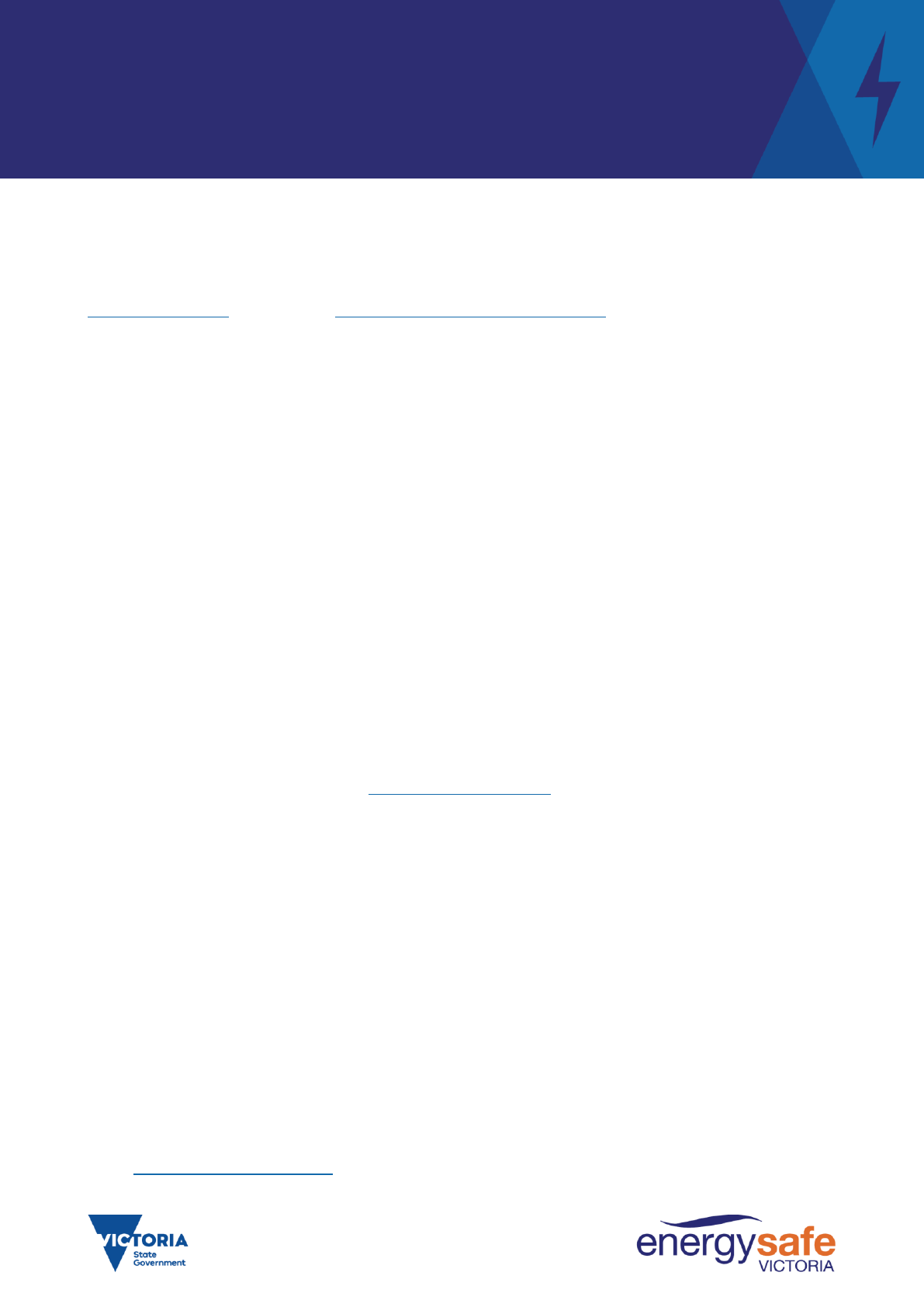
Certificates of Electrical Safety
Fundamentals
Purpose
The purpose of this document is to assist the electrical industry in understanding the requirements for
purchasing, completing, lodging and distributing Certificates of Electrical Safety (COES) as specified by the
Electricity Safety Act (ESA) and the Electricity Safety (General) Regulations (ES(G)R).
Application
The purchase, completion, certification, lodgement and distribution requirements for Certificates of
Compliance that form part of the Certificate of Electrical Safety apply to Registered Electrical Contractors
(RECs) and Licensed Electrical Workers (LEWs) performing electrical installation work in Victoria.
The completion, certification, lodgement and distribution of Certificates of Inspection that form part of a
Prescribed Certificate of Electrical Safety apply to Licensed Electrical Inspectors (LEIs) performing electrical
inspection work in Victoria.
The COES System
The Energy Safe Victoria (ESV) COES system aims to:
improve electrical safety for the general public, electricity customers and electrical workers,
ensure that all electrical installation work is undertaken only by qualified persons,
ensure completed electrical work is available to be audited for compliance, and
educate the industry.
Your legal responsibilities under the Act and Regulations
It is the duty of the Responsible Person (REC Technical Supervisor, Electrician, Restricted Electrical Licence
holder, Switchgear Licence holder) and Licensed Electrical Inspectors (LEIs) to understand their obligations
under legislation.
All provisions of the (ESA) and (ES(G)R) pertaining to COES and electrical inspections are mandatory
requirements.
The ESA and ES(G)R require:
a COES to be completed and certified for all electrical installation work performed
Note: Failure to comply with this requirement is an offence under the Act and Regulations, and
licensed workers may be subject to disciplinary action or prosecution for noncompliance.
the licensed electrical worker must accurately describe the electrical installation work performed on a
Certificate of Compliance. This provides the customer with an accurate record of the electrical
installation work performed within their installation and provides ESV compliance officers and
auditors clear information of the work to be audited.
a LEI must ensure that the details on the Certificate of Compliance are complete, accurate and
legible.
You can contact the ESV COES team for further information by phone 03 9203 9700 (option 3) or
email: coes@energysafe.vic.gov.au

Energy Safe Victoria
COES fundamentals August 2021 Page 2
Types of COES
Certificate Type
Description
Prescribed
Prescribed electrical installation work requiring inspection
Prescribed electrical installation work means work on all or part of any of the
following electrical installations, if they are ordinarily operated at low voltage or a
voltage exceeding low voltage:
(1) Consumers’ mains, main earthing systems and those parts of main
switchboards that are related to the control of installations and the
protection against the spread of fire.
(2) Sub-mains, earthing systems and any distribution boards related to the
control of individual occupier’s portions of multiple installations unless the
occupier has immediate and unimpeded access to the main switch or
switches controlling the whole of the multiple installation.
(3) Electrical wiring and electrical equipment installed in hazardous areas
within the meaning of section 7 of AS/NZS 3000 the Australian/New
Zealand Wiring Rules and protection equipment associated with hazardous
areas.
(4) High voltage installations except high voltage wiring and equipment that is:
associated with an electric discharge lighting system, or
associated with X-ray equipment, or
associated with high frequency equipment, or
within self-contained equipment supplied at low voltage.
(5) Electrical control and protection equipment associated with standby
generation or co-generation electricity supply systems, battery energy
storage system including work on associated wiring systems, switchgear,
controlgear and accessories
(6) Electric fences used for security purposes but not including electric fences
intended primarily for the control or containment of animals.
(7) Electrical installations comprising remote area power supplies with a power
rating exceeding 500 volt amperes not connected to a supply authority
distribution system.
(8) Electrical wiring and associated fixed electrical equipment installed in body-
protected or cardiac-protected electrical areas of hospitals and medical and
dental practices.
(9) Circuit protective devices, switchgear, controlgear, wiring systems and
accessories (other than fire detection and alarm systems) ordinarily
operated at low voltage or a voltage exceeding low voltage installed to
provide control and protection of passenger lifts, fire pumps (excluding
pumps for fire hose reels where those hose reels are not the sole means of
fire protection) and air handling systems intended to exhaust and control
the spread of fire and smoke.
(10) A part 1 solution ordinarily operated at low voltage or a voltage exceeding
low voltage installed in an electrical installation.
Non Prescribed
Non-prescribed electrical installation work
Non-prescribed electrical installation work means work other than listed as
prescribed electrical installation work, and
For the purpose of Section 45 of the Electricity Safety Act 1998, ‘prescribed
electrical installation work’ does not include –
the repair or maintenance of a single component part of an electrical

Energy Safe Victoria
COES fundamentals August 2021 Page 3
installation; or
the replacement of a single component part of an electrical installation by
an equivalent component part at the same location.
Periodic
Non-prescribed electrical installation work at one site over a 3 month period
Periodic COES allow non-prescribed electrical installation work to be performed at a
single electrical installation for a period of three months.
Further information on Prescribed and Non-prescribed work and the Practical guide to using COES is
available on the ESV website.
The responsible person
The responsible person with respect to a certificate of electrical safety is responsible for:
the purchase of certificates for use,
the management of certificates during and at completion, and
distribution to all relevant parties.
The responsible person:
For an REC is the Technical supervisor.
In all other cases, the responsible person is the LEW i.e., Electrician/Switchgear/Restricted licence
holder where the electrical work is for an employer at an employer’s site or for yourself (no profit or
gain) or Restricted Electrical licence holder as supplementary to your primary trade.
The licensed electrical worker
The licensed electrical worker with respect to a certificate of electrical safety is responsible for:
completing and testing the electrical installation work,
completing all details on the certificate of compliance accurately and legibly, and
certifying the certificate of compliance.
Note: An LEW certifying a certificate of compliance that forms part of the COES must understand the
declaration at the bottom of each certificate is a legal declaration that the electrical installation work you
completed has been tested and complies with the Electricity Safety Act 1998 and the Electricity Safety
(General) Regulations (The Law).
The licensed electrical inspector
The licensed electrical inspector with respect to a prescribed certificate of electrical safety is responsible for:
inspecting and testing the electrical installation work,
completing all details on the certificate of inspection accurately and legibly,
identifying any electrical installation defects on the certificate of inspection,
certifying the certificate of inspection, and
confirming the safety of the installation for connection to electricity supply.
COES systems
Energy Safe Victoria provides COES to the industry in two ways;
ESVConnect COES (electronic), or
Paper COES forms.

Energy Safe Victoria
COES fundamentals August 2021 Page 4
ESVConnect system
Purchase
Purchase Prescribed and/or Non-prescribed certificates under the appropriate licence or REC profile
accessible from the ESVConnect home page for use.
Purchased certificates are available in a certificates pool until all are used.
Completion
The Licensed Electrical Worker must:
complete all mandatory details in the fields provided on the Certificate of Compliance,
tick the declaration provided then certify each certificate by clicking submit.
Once complete, the Responsible Person can:
review and approve the certificate to move the certificate to the next step in the process, or
review and return the certificate to move it back to draft stage and amend any details as required.
Once approved, allocate a prescribed certificate to an LEI/Inspection company for inspection.
The Licensed Electrical Inspector must:
complete the prescribed Certificate of Inspection fields.
Note: The LEI can return the certificate to the Responsible Person for amendments / rectifications if required.
Lodgement
Lodgement is complete when the Certificate of Electrical Safety is generated.
Distribution
The Responsible Person can provide the certificate to their customer in two ways:
Download and email the certificate, or
Enter the customers email address into the ‘Customer email’ field during certificate completion and
your customer will receive the certificate automatically when the COES is generated.
Note: 1. ESV does not require electronic certificates to be sent to ESV as they are available in the
ESVConnect system.
2. The Responsible Person must provide a copy of the COES to the customer upon
completion. Your customer is the person or business that engaged you to perform the work.
Further ESVConnect information is available on the Energy Safe Victoria website via the following links:
ESVConnect COES webpage
ESVConnect COES guide provides certificate process information for all industry representatives.
COES fees
Licensed Electrical Inspector register
Inspection company register
COES defect list
Your responsibilities is available on the ESV website

Energy Safe Victoria
COES fundamentals August 2021 Page 5
Paper COES system
Purchase
Paper Prescribed and Non prescribed COES are available at electrical wholesalers.
Paper Periodic COES are available through the COES order form on the ESV website.
You will need to provide the applicable user ID when purchasing paper COES forms. If you are
unsure of your User ID details, please contact ESV.
Completion
The responsible person and the licensed electrical worker must complete the certificate by writing all details
on the front page of the certificate ensuring that all entered details are replicated on all other copies.
The licensed electrical worker must sign the certificate of compliance section of the COES.
The responsible person must organise an LEI/Inspection company to perform the inspection of work on a
prescribed certificate.
The licensed electrical inspector must complete the prescribed certificate of inspection fields.
Lodgement
Paper COES can only be lodged via the IVR system. Call 1300 360 366, log in using your User ID details
that you purchased the certificate under and follow the prompts.
The responsible person must lodge the certificate of compliance details within 2 days of certification.
This responsible person lodgement of a prescribed certificate of compliance provides the inspecting
LEI the ability to lodge the certificate of inspection once the inspection is complete.
Note: A LEI is unable to lodge a paper certificate of inspection until the certificate of compliance
details have been lodged by the responsible person.
LEIs must lodge paper certificates of inspection through the IVR system within 4 days of inspection
completion. Call 1300 360 366, log in using your LEI User ID details and follow the prompts.
Distribution
The responsible person must distribute all copies of the completed certificate to the parties identified on each
copy within the prescribed time frames. The white ESV copy must be posted to Energy Safe Victoria for
scanning into our database.
Note: The Responsible Person must provide a copy of the COES to the customer upon completion. Your
customer is the person or business that engaged you to perform the work.
Further paper COES information is available on the Energy Safe Victoria website via the following links:
Paper COES webpage of the Energy Safe Victoria website
Paper COES guides provides certificate process information for all industry representatives
COES fees
Licensed Electrical Inspector register
Inspection company register
COES defect list
Your responsibilities is available on the ESV website

Energy Safe Victoria
COES fundamentals August 2021 Page 6
COES completion information
Responsible person
The details in this section pertain to the person or business that has been engaged to perform electrical
installation work:
REC details – if the electrical work is for profit or gain.
LEW details – if the electrical work is for an employer at an employer’s site, or for yourself (no profit or
gain).
Note: LEWs must understand that when working for no profit or gain they are not covered by any insurance.
Customer details
The details in this section pertain to the person or business that engaged you to perform the electrical work
and the address where the work was performed.
Customer name and phone number – the name of the person or business that engaged you to
perform the electrical work and their regular/daily contact number.
Address – the address where the electrical work was performed.
Description of work
The details in this section pertain to the electrical work you performed and the description of work must be
detailed, accurate and legible.
The description of work should identify:
If the work is a new installation or repair/replacement,
How many of the item you installed,
The type of item you installed,
Where you installed each item, and
Include load ratings (kW) of any equipment installed.
Maximum demand and Consumers mains capacity
Maximum demand –
When the electrical installation work performed increases the load on the installation you are
required to provide the new maximum demand current, any 1 of the 4 applicable methods available
in AS/NZS 3000 is suitable.
Where the electrical installation work performed does not increase the load on the installation e.g. a
repair, you can insert ‘As Before’ in the maximum demand field.
Consumers Mains capacity –
Consumers Mains capacity can be calculated in accordance with AS/NZS 3000 or AS/NZS 3008.1.1.
Where a fixed setting circuit breaker (example: 63Amp circuit breaker) is installed as the main
switch, you can insert the following into the consumers mains capacity field, ‘63A limited’.
Type of electrical installation work
The details in this section pertain to the type of electrical work you performed.
One or more must be selected to clearly identify the type of electrical installation work completed.
Failed previous inspection/audit
The details in this section pertain to any electrical installation work that was certified on a COES and requires
rectification due to failing an inspection or audit.
The new certificate you are completing must include the original COES number of the electrical work that
failed the inspection or audit.
Further assistance regarding electrical installation work that has been defected is available from the ESV
COES team. Call 03 9203 9700 (option 3) or email [email protected].au.

Energy Safe Victoria
COES fundamentals August 2021 Page 7
Definitions
Act means a statute or law passed by both Houses of Parliament that has received Royal Assent. Acts are
also known as primary legislation.
Legislation means Acts of Parliament and the secondary legislation made under them. The term legislation
can refer to a single law or to a collection of laws.
Statutory rules (SRs) means all Regulations made under an Act of Parliament.
Certificate of compliance means a certificate of compliance completed under ESA section 44 for electrical
installation work carried out by a licensed electrical installation worker.
Certificate of inspection means a certificate of inspection of electrical installation work carried out by a
licensed electrical inspector under ESA section 45.
A certificate of electrical safety must contain—
(a) a certificate of compliance completed under ESA section 44 for the installation work by the
licensed electrical installation worker who carried out the work; and
(b) in the case of prescribed electrical installation work, a certificate of inspection of the
installation work completed under ESA section 45 by a licensed electrical inspector.
Electrical connection work means connecting or disconnecting electrical equipment to or from a supply of
electricity.
Electrical equipment means any appliance, wire, fitting, cable, conduit or apparatus that generates, uses,
conveys or controls (or that is intended to generate, use, convey or control) electricity.
Electrical equipment work means repair, alteration or maintenance of electrical equipment.
Electrical installation means electrical equipment that is fixed or to be fixed in, on, under or over any land
but does not include a part of a supply network—
(a) of a railway; or
(b) owned or operated by a major electricity company.
Electrical installation work means installation, alteration, repair or maintenance of an electrical installation.
Electrical installation worker means a person who carries out electrical installation work.
Electrical work means—
(a) electrical connection work; or
(b) electrical equipment work; or
(c) electrical inspection work; or
(d) electrical installation work.
Electrical worker means a person who carries out electrical work.
Who we are
We are Victoria’s safety regulator for electricity, gas and pipelines.
Our role is to ensure that Victorian gas and electricity industries are safe and meet community expectations.
We are also responsible for licensing and registering electricians, and educating the community about
energy safety.
More information is available on the Energy Safe Victoria website: www.esv.vic.gov.au
You can contact the ESV COES team for further information by phone 03 9203 9700 (option 3) or
email: coes@energysafe.vic.gov.au
